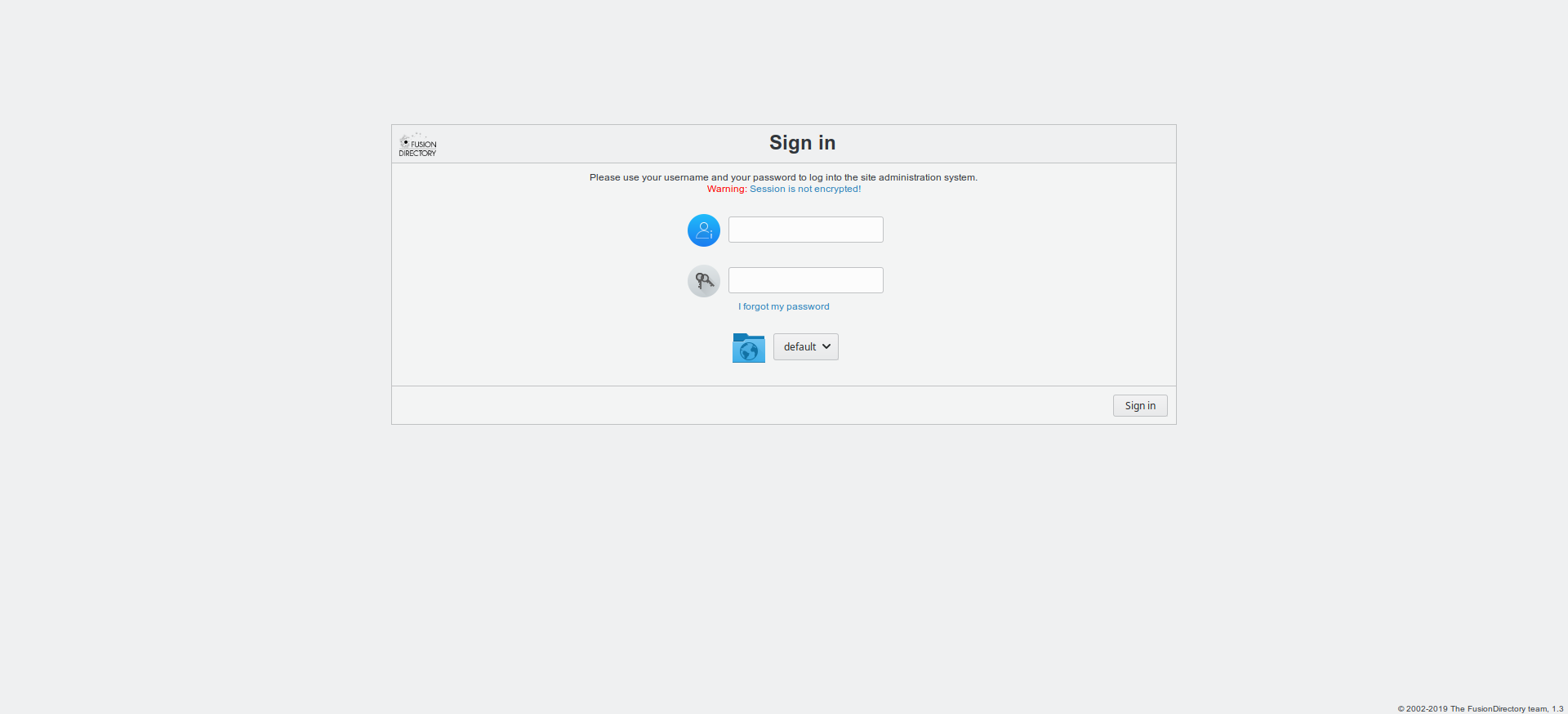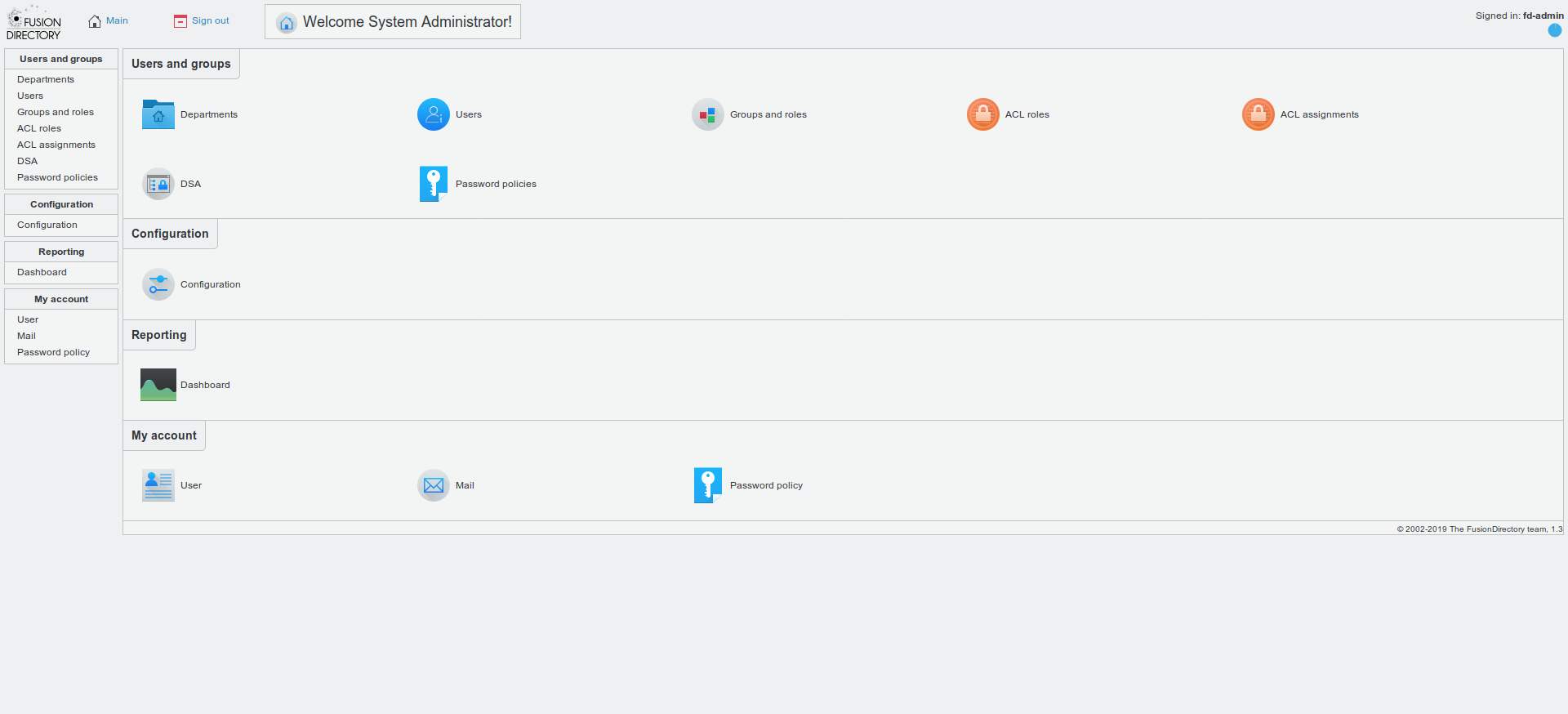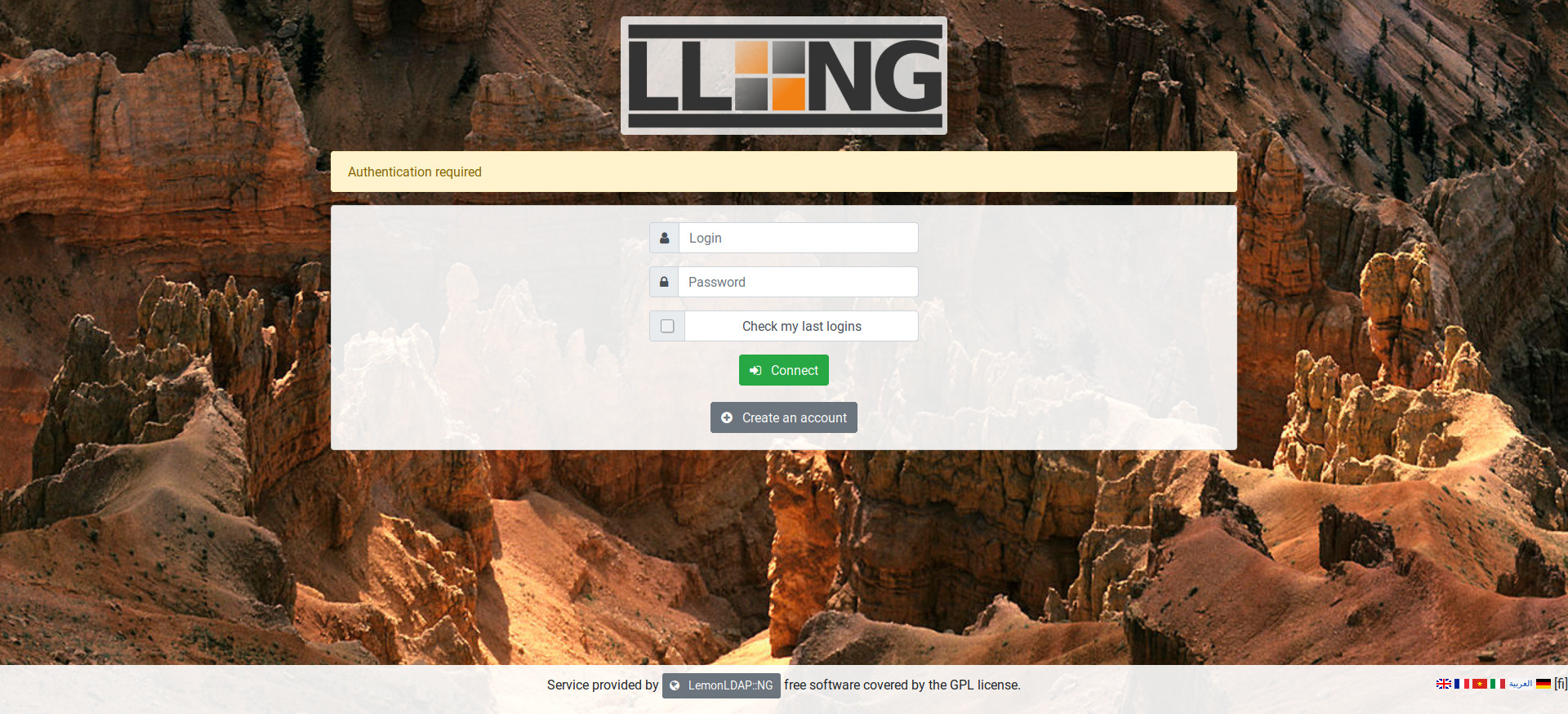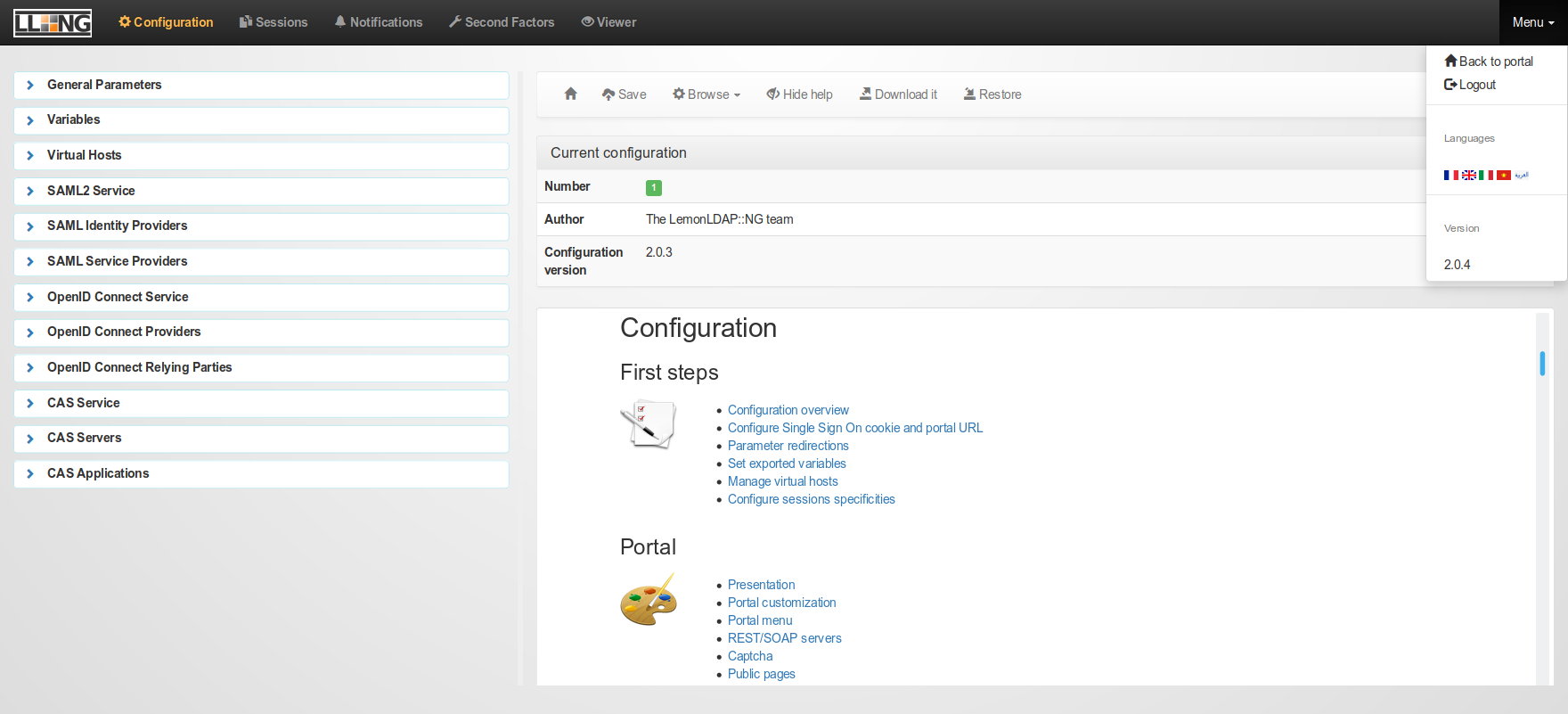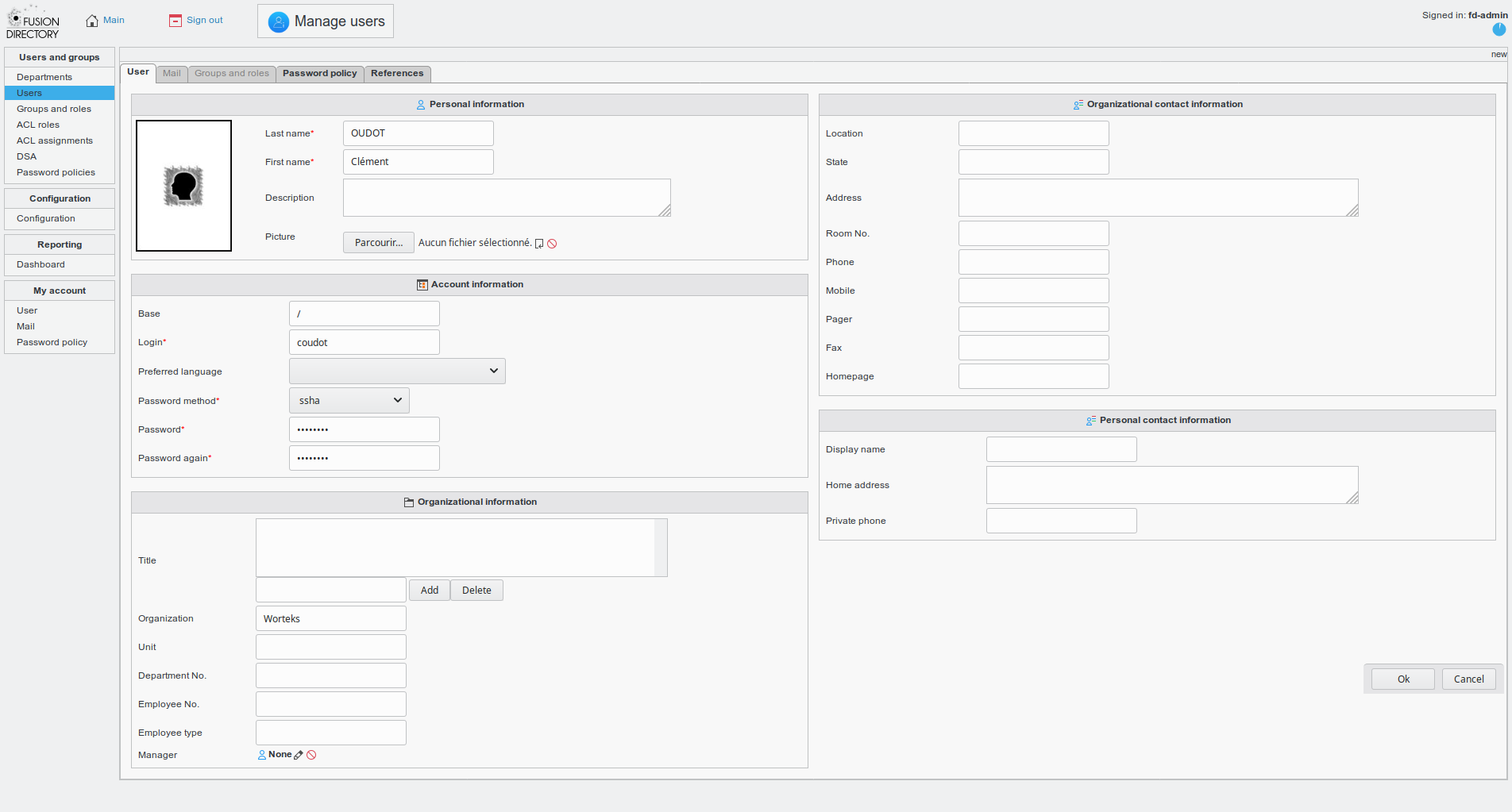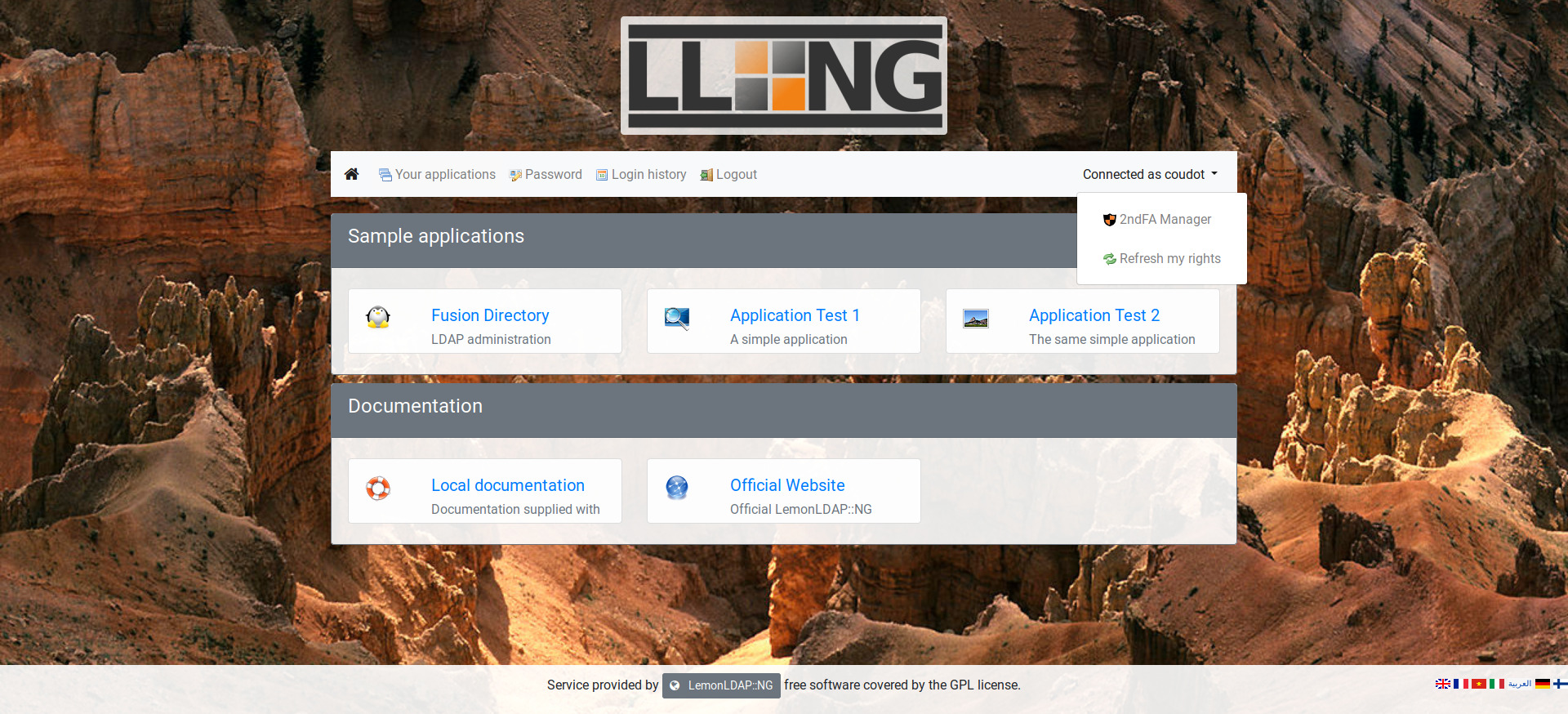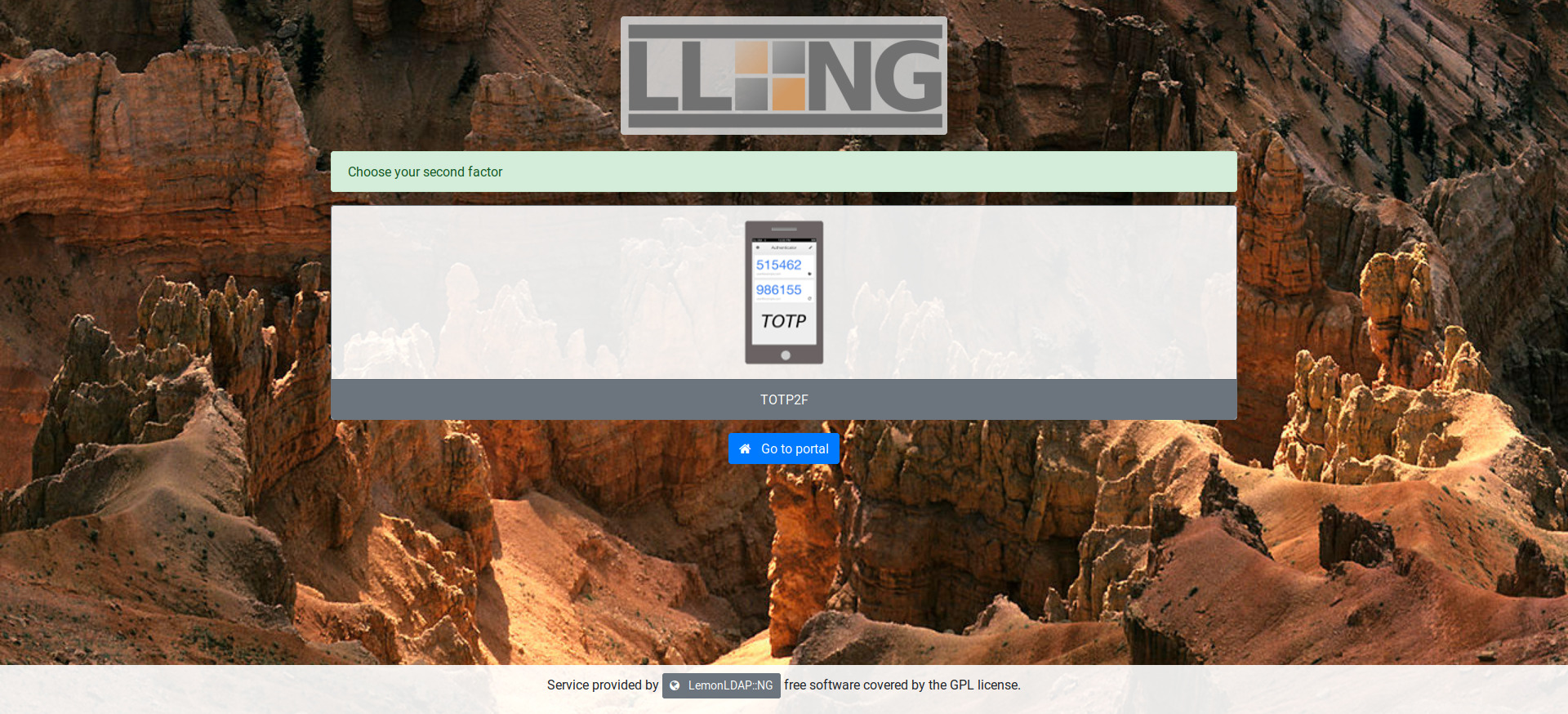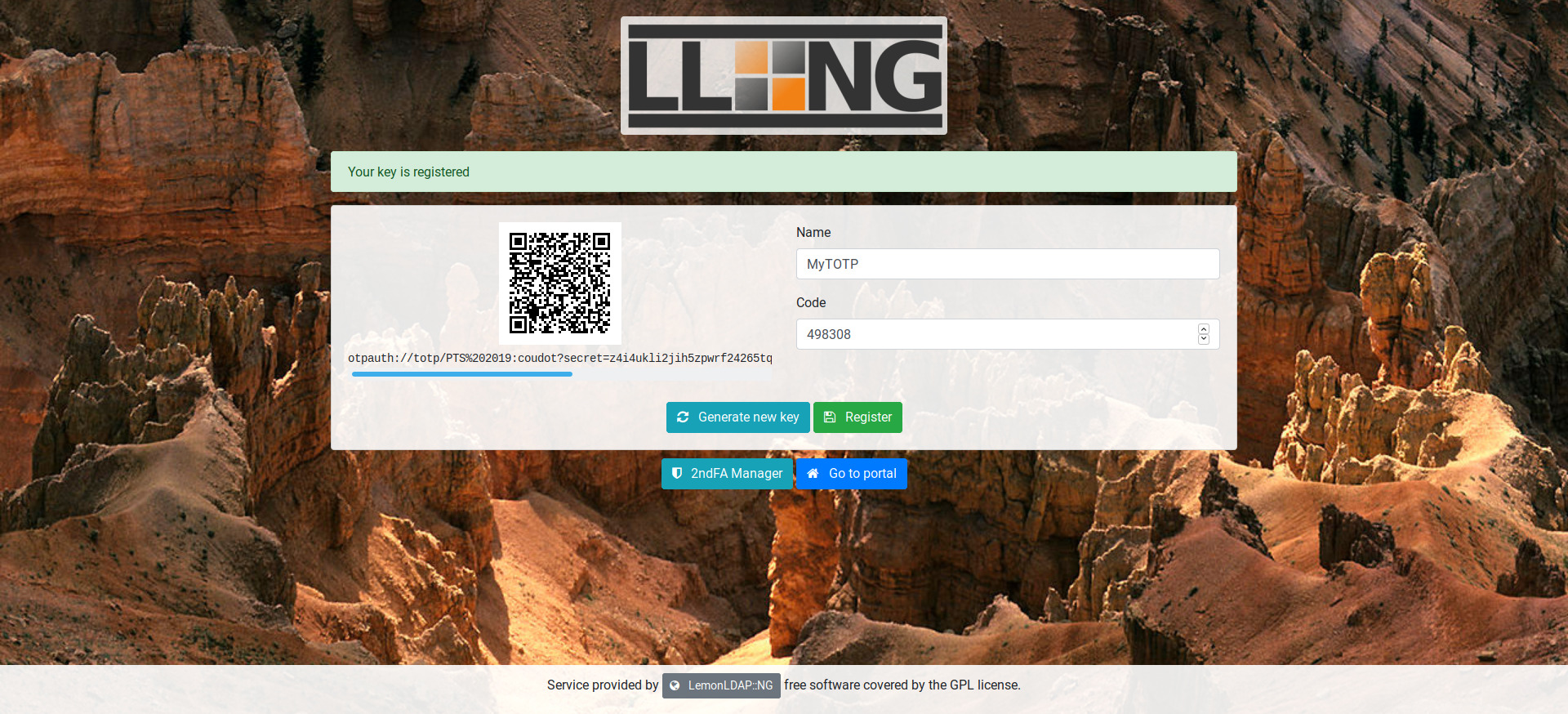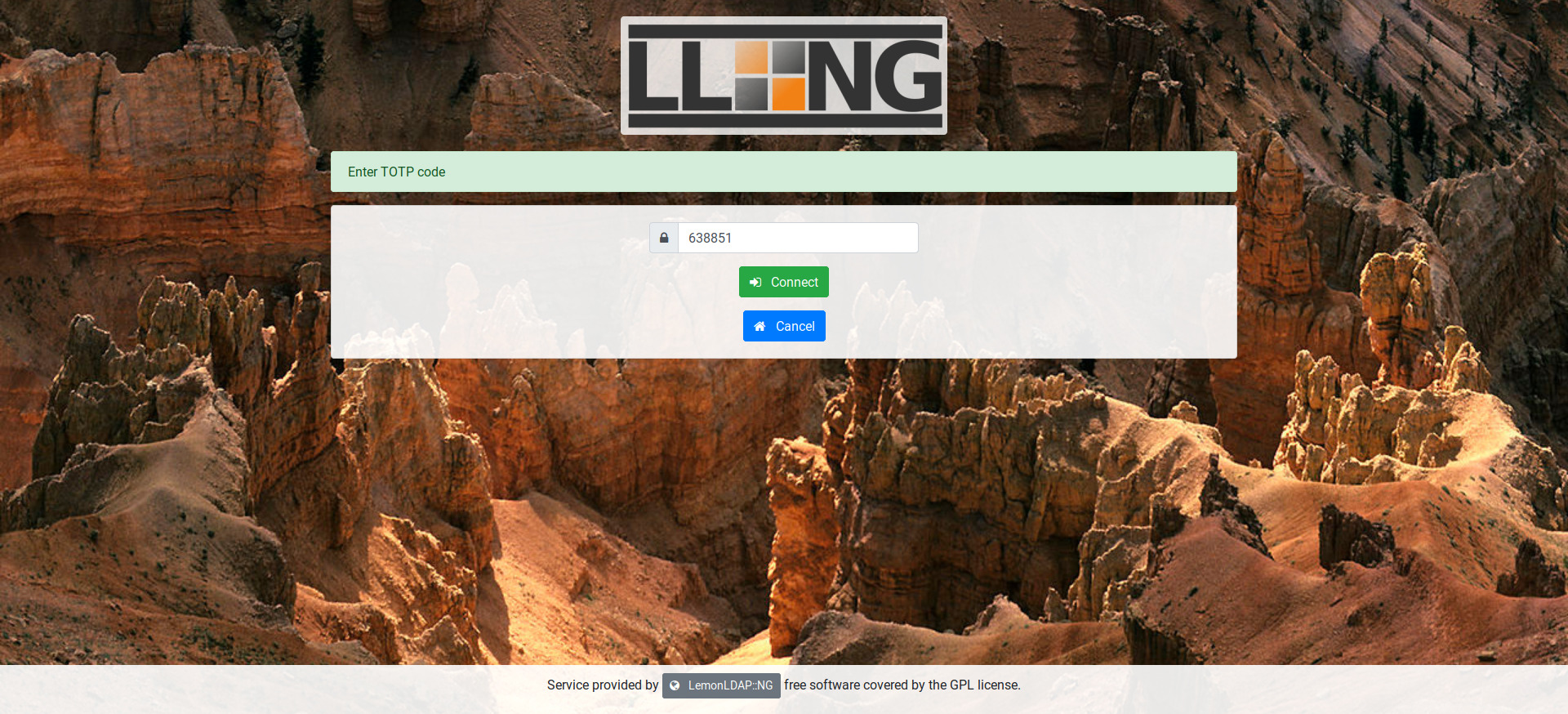Workshop on LemonLDAP::NG for LDAPCon 2019.
Goals:
- Install LemonLDAP::NG
- Configure authentication to OpenLDAP
- Protect sample applications with Handler
- Enable 2FA
Prerequisites:
- Virtualization system (like VirtualBox)
- Internet access from your Virtual Machine (for packages installation)
- Mobile phone with TOTP application (for example FreeOTP+)
Download the virtual image from Worteks CDN and import it.
After starting the image, you should be able to log in on graphcal inteface with:
:bust_in_silhouette: worteks
🔑 password
❗ the keyboard layout is in english by default, so try pqsszord if you are login with another layout. Once logged into graphical session, you can change the keyboard layout from task bar.
And then open a console (ALT+F2 konsole)
su -
The root password is 🔑 password
ℹ️ For practical reasons we will use a browser on local machine to access applications. If you can access your Virtual Machine from your host, you will also be able to use your own browser. In this case, edit your /etc/hosts file to map URLs to the IP of your Virtual Machine.
❗ All commands in this documentation must be run as root in the console.
OpenLDAP LTB server is already installed, you can check the service status:
systemctl status slapd
Access to configuration:
ldapvi -Y EXTERNAL -h ldapi:/// -b cn=config
Access to data:
ldapvi -Y EXTERNAL -h ldapi:/// -b dc=worteks,dc=com
Some specific commands are available with slapd CLI script provided by LTB packages.
Extended status:
slapd-cli status
Data and configuration backup:
chown -R ldap:ldap /var/backups/openldap
slapd-cli backup
slapd-cli backupconfig
Restore commands will use the most recent backup files:
slapd-cli restore
slapd-cli restoreconfig
ℹ️ More information on https://ltb-project.org/documentation/openldap-initscript
Fusion Directory is already installed, you can access it on http://localhost/fusiondirectory/
You should see the following screen:
Log in with:
:bust_in_silhouette: fd-admin
🔑 password
You should see the following screen:
❗ Now you are on your own. Follow the following steps and try to achieve all points!
ℹ️ See also official documentation.
Use official repository:
vi /etc/apt/sources.list.d/lemonldap-ng.list
# LemonLDAP::NG repository
deb https://lemonldap-ng.org/deb 2.0 main
deb-src https://lemonldap-ng.org/deb 2.0 main
Get GPG key:
wget -O - https://lemonldap-ng.org/_media/rpm-gpg-key-ow2 | apt-key add -
Update:
apt update
Install main package with Apache mod_perl:
apt install libapache2-mod-perl2 lemonldap-ng
ℹ️ LemonLDAP::NG is of course also compatible with Nginx, but this workshop is designed to run with Apache.
Install Apache FCGID module:
apt install libapache2-mod-fcgid
Enable modules and configurations:
a2ensite manager-apache2.conf
a2ensite portal-apache2.conf
a2ensite handler-apache2.conf
a2enmod fcgid perl alias rewrite headers
Configure LL::NG to check configuration every second (avoid to force a restart at each configuration modification):
sed -i 's/;checkTime =.*/checkTime = 1/' /etc/lemonldap-ng/lemonldap-ng.ini
Test configuration:
apachectl configtest
Restart Apache:
systemctl restart apache2
ℹ️ We use the default domain example.com. LemonLDAP::NG can be of course configured on other domain, but this beyond the scope of this workshop.
Configure your local DNS or edit your local /etc/hosts (on your host, not on the virtual machine) with:
127.0.0.1 auth.example.com manager.example.com test1.example.com test2.example.com
Then open the web browser and go to http://auth.example.com
You should see the following screen:
Log in with:
:bust_in_silhouette: dwho
🔑 dwho
You should see the following screen:
Click on WebSSO Manager to access the administration interface, or use http://manager.example.com
You should see the following screen:
ℹ️ Further configuration steps could be done with this graphical interface, but in this workshop we will use the Command Line Interface:
/usr/share/lemonldap-ng/bin/lemonldap-ng-cli help
LemonLDAP::NG provides a sample application that reads HTTP headers. To enable it:
a2ensite test-apache2.conf
systemctl reload apache2
You can see that this is a standard Apache virtual host, the only added line it the call the LL::NG Handler:
vi /etc/apache2/sites-enabled/test-apache2.conf
# SSO protection
PerlHeaderParserHandler Lemonldap::NG::Handler::ApacheMP2Access to the sample application: http://test1.example.com
You should see the following element in the screen:
You are authenticated! If you logout from the WebSSO (http://auth.example.com/logout), and try to access to the sample application, you will be forced to log in.
The WebSSO is currently in demo mode, with built-in accounts (do you like Doctor Who?). Now we will configure LemonLDAP::NG to use the local LDAP directory.
Use the command line to set LDAP parameters:
/usr/share/lemonldap-ng/bin/lemonldap-ng-cli -yes 1 \
set \
authentication LDAP \
userDB LDAP \
passwordDB LDAP \
registerDB LDAP \
ldapServer 'ldap://localhost' \
managerDn 'cn=websso,ou=dsa,dc=worteks,dc=com' \
managerPassword 'WebSSOPassword' \
ldapBase 'ou=users,dc=worteks,dc=com' \
ldapPpolicyControl 1
/usr/share/lemonldap-ng/bin/lemonldap-ng-cli -yes 1 \
addKey \
ldapExportedVars uid uid \
ldapExportedVars cn cn \
ldapExportedVars sn sn \
ldapExportedVars mail mail \
ldapExportedVars givenName givenName
Now you can connect to SSO portal with the LDAP user:
:bust_in_silhouette: fd-admin
🔑 password
As you can see, access to Manager is not granted anymore. Indeed, this access was configured for user dwho and you are not this one anymore!
To restore access to Manager, two options:
- Remove Manager protection in
/etc/lemonldap-ng/lemonldap-ng.ini(search[manager]section andprotectionparameter) - Modify access rules
For the second solution, first remove unused rules:
/usr/share/lemonldap-ng/bin/lemonldap-ng-cli -yes 1 \
delKey \
locationRules/manager.example.com '(?#Configuration)^/(.*?\.(fcgi|psgi)/)?(manager\.html|confs/|$)' \
locationRules/manager.example.com '(?#Sessions)/(.*?\.(fcgi|psgi)/)?sessions' \
locationRules/manager.example.com '(?#Notifications)/(.*?\.(fcgi|psgi)/)?notifications'
Then change default rule:
/usr/share/lemonldap-ng/bin/lemonldap-ng-cli -yes 1 \
addKey \
locationRules/manager.example.com default '$uid =~ /^fd-admin$/'
Now the user fd-admin can access the Manager.
Fusion Directory is a web application compatible with several SSO methods:
- HTTP headers
- CAS
We will use the first method, which is how LemonLDAP::NG works by default.
ℹ️ LemonLDAP::NG can also be configured as Identity Provider for CAS, SAML and OpenID Connect!
The first step is to create an Apache virtual host for Fusion Directory:
vi /etc/apache2/sites-available/fd.conf
<VirtualHost "*:80">
ServerName fd.example.com
# SSO protection
PerlHeaderParserHandler Lemonldap::NG::Handler::ApacheMP2
# DocumentRoot
DocumentRoot /usr/share/fusiondirectory/html
</VirtualHost>Enable this virtual host:
a2ensite fd
systemctl reload apache2
Configure your local DNS or edit your local /etc/hosts (on your host, not on the virtual machine) with:
127.0.0.1 fd.example.com
If you try to access http://fd.example.com, you will be rejected. This is because the virtual host is not yet defined in LL::NG.
To do it:
/usr/share/lemonldap-ng/bin/lemonldap-ng-cli -yes 1 \
addKey \
'locationRules/fd.example.com' 'default' 'accept' \
'locationRules/fd.example.com' '(?#Logout)^/index\.php\?signout=1' 'logout_sso' \
'exportedHeaders/fd.example.com' 'Auth-User' '$uid'
You can see in the command that we create a default rule to allow every authenticated user (accept) and we also provide a rule to catch the logout URL and disconnect users from the WebSSO (logout_sso). The last line set the exported header (Auth-User) and which session value will be set in ($uid).
Go to Fusion Directory with the new URL. You still need to authenticate as the application is not yet configured to trust the WebSSO.
Go in Configuration menu, click on Edit button (bottom right). Then in Login and Session check HTTP Header authentication box and keep the value of Header name (AUTH_USER).
Click on Sign out: you are disconnected from the WebSSO. Now go on http://fd.example.com again, you should be redirected to WebSSO login form. Authenticate, and then you are redirected back to the application, and you are already authenticated!
Now that you set a trust between Fusion Directory and LemonLDAP::NG, you must ensure that nobody can access the application outside the WebSSO. It is indeed very easy to forge an HTTP header, so an attacker could connect to the application with any account.
Disable direct access configuration:
a2disconf fusiondirectory
systemctl reload apache2
This step is not mandatory, but will allow to see the application inside the menu.
First, check which categories are defined:
/usr/share/lemonldap-ng/bin/lemonldap-ng-cli get applicationList
applicationList has the following keys:
1sample
2administration
3documentation
We will create the application in the 1sample category:
/usr/share/lemonldap-ng/bin/lemonldap-ng-cli -yes 1 \
addKey \
applicationList/1sample/fd type application \
applicationList/1sample/fd/options description "LDAP administration" \
applicationList/1sample/fd/options display "auto" \
applicationList/1sample/fd/options logo "tux.png" \
applicationList/1sample/fd/options name "Fusion Directory" \
applicationList/1sample/fd/options uri "http://fd.example.com/"
No the application should appear in the menu.
We can now create a new account. With Fusion Directory, fo in Users, then Actions > Create > User.
Fill the information, at least first name, last name, login and password:
Save and log out. You should now be able to log with this account. It has the default rights: no access to WebSSO Manager but access to other applications.
ℹ️ See also official documentation.
For the workshop, we will set up a TOTP second factor. You will need a mobile phone with a TOTP application, like FreeOTP+.
First, install required dependencies:
apt install libdigest-hmac-perl
Here are the configuration settings we will use:
- Self registration: enabled (users can register their 2FA)
- Authentication level: 5 (at least higher than the LDAP authentication level)
- Issuer: Workshop LemonLDAPNG (or any name that you want to be displayed on user application)
- Interval: 30 (this is the default)
- Range: 1 (this is the default)
- Digits: 6 (this is the default)
- Display existing secret: enabled (users can see their own 2FA)
- Change existing secret: enabled (users can change their 2FA)
- Delete TOTP: enabled (users can remove their 2FA)
- Lifetime: unlimited
Apply these settings:
/usr/share/lemonldap-ng/bin/lemonldap-ng-cli -yes 1 \
set \
totp2fActivation 1 \
totp2fSelfRegistration 1 \
totp2fAuthnLevel 5 \
totp2fIssuer "Workshop LemonLDAPNG" \
totp2fInterval 30 \
totp2fRange 1 \
totp2fDigits 6 \
totp2fDisplayExistingSecret 1 \
totp2fUserCanChangeKey 1 \
totp2fUserCanRemoveKey 1 \
totp2fTTL 0
Now connect with your account on WebSSO portal and go to 2ndFA Manager:
Choose your second factor (only TOTP should be available):
Now take your phone, open your OTP application and scan the QR-code. You can now generate an OTP from your application. Enter this OTP on WebSSO page to regsiter your device:
Go back to portal and log out. Then log in again with your account, the second factor is required:
Enter the code and submit, you should now be authenticated!
ℹ️ If you connect with fd-admin account again, you can access to Manager and click an Second Factor tab. You should see a session for the user. As administrator, you can reset the 2FA so the user will be able to connect without it and register a new one.
You can create a new user in LDAP and connect with him, but without registering a 2FA. He will have the default authentication level.
To request at least level 4 for application "test2.example.com", do the following:
/usr/share/lemonldap-ng/bin/lemonldap-ng-cli -yes 1 \
addKey \
locationRules/test2.example.com default '$authenticationLevel >= 4'
Now connect with the user without 2FA: application test2 is not authorized. If you connect with the user having 2FA, the application is authorized.
To go further, we can apply what we learn to install Dokuwik and integrate it in LemonLDAP::NG.
First install it:
apt install dokuwiki
You can access the application on http://localhost/dokuwiki/ and log in with the admin password you registered during installation process.
To allow configuration trough Dokuwiki interface, we will adapt some rights on file system. This is not mandatory if you prefer ton configure Dokuwiki only from the console.
chown -R www-data:www-data /etc/dokuwiki
chown -R www-data:www-data /var/lib/dokuwiki/lib/plugins
We will apply the same steps with Dokuwiki than the ones used to configure SSO on Fusion Directory.
First create the virtual host:
vi /etc/apache2/sites-available/dokuwiki.conf
<VirtualHost "*:80">
ServerName dokuwiki.example.com
# SSO protection
PerlHeaderParserHandler Lemonldap::NG::Handler::ApacheMP2
# DocumentRoot
DocumentRoot /usr/share/dokuwiki
<Directory /usr/share/dokuwiki/bin>
Require all denied
</Directory>
<Directory /var/lib/dokuwiki/data>
Require all denied
</Directory>
</VirtualHost>Enable this virtual host:
a2ensite dokuwiki
systemctl reload apache2
Configure your local DNS or edit your local /etc/hosts (on your host, not on the virtual machine) with:
127.0.0.1 dokuwiki.example.com
Declare the application in LemonLDAP::NG:
/usr/share/lemonldap-ng/bin/lemonldap-ng-cli -yes 1 \
addKey \
'locationRules/dokuwiki.example.com' 'default' 'accept' \
'exportedHeaders/dokuwiki.example.com' 'Auth-User' '$uid' \
'exportedHeaders/dokuwiki.example.com' 'Auth-Cn' '$cn' \
'exportedHeaders/dokuwiki.example.com' 'Auth-Mail' '$mail'
From Dokuwiki interface, connected as admin, go in administration menu:
- In extension manager, search for
lemonldapand install the plugin - In configuration settings, change the authentication backend to
lemonldap
You will then be logged out by dokuwiki. Log in now on http://dokuwiki.example.com with your standard user, you should be logged in with your identifier and name.
You can now disable old apache configuration:
a2disconf dokuwiki
systemctl reload apache2
ℹ️ See also official documentation.
You now have a working SSO system with several applications configured. LemonLDAP::NG has a lot of features than you can test, for example:
- LDAP password policy
- LDAP group recursive search
- CAS, SAML, OpenID Connect provider
- Complex access rules based on LDAP attributes, groups and environment variables
Browse the online configuration to know more!

